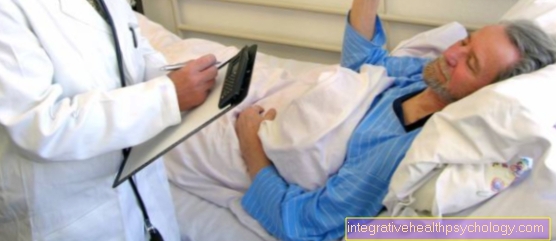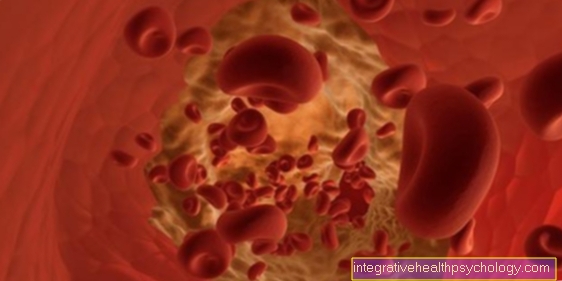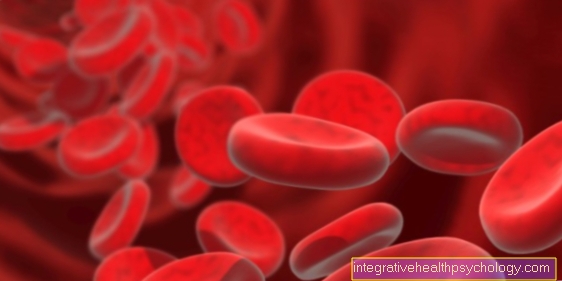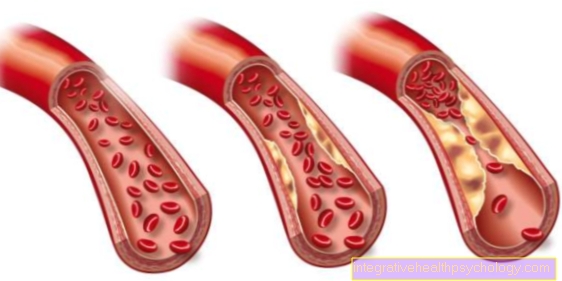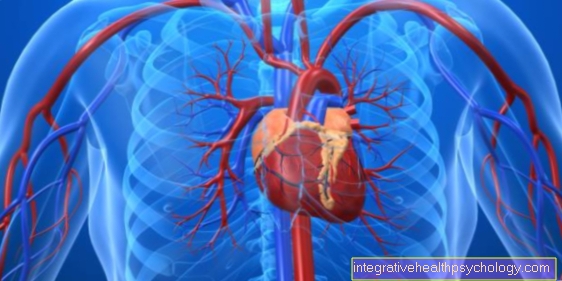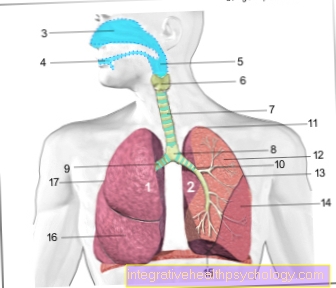Sympathetic
Synonyms in the broader sense
autonomic nervous system, sympaticus
definition
The sympathetic nervous system is the antagonist of the parasympathetic nervous system and - like it - is a part of the vegetative (also: autonomous) nervous system.
The autonomous nervous system is important for the control of our organs and glands, it is called autonomous because we cannot control it arbitrarily, it runs "alongside" without us being constantly aware of it (just think about breathing, digesting and Sweat)

To the Sympathetic To define his tasks very briefly, one could say that he triggers everything that makes an escape reaction (back then, hundreds of years ago because of the tiger in the thicket, today, instead of “escape”, it is often stress or panic because of a direct upcoming exam or similar). As a result of increased sympathetic activity, our body functions change as follows:
- faster heartbeat (higher Heart rate and stronger contraction)
- Vasodilation (so that more blood can flow, because the heart needs more oxygen to do more work)
- faster breathing
- increased sweating
- increased Blood pressure
- Dilated pupil
- decreased activity of the digestive tract
- decreased urination (Continence)
So now it has become clear WHAT the sympathetic triggers, yes HOW he does it and WHERE in the body it is still to be clarified.
localization

The sympathetic nervous system should not be thought of as a single "point" in the body. Rather, it is distributed over a fairly large part of the body. It has a place where its origin lies (i.e. the cells, which are a kind of command center) and a kind of rail system (i.e. the fibers that emanate from the cells and ensure that what the command center "cell" commands, is forwarded to the recipient). The recipient of the commands are the organs on which the sympathetic system acts (heart, lungs, gastrointestinal tract, blood vessels, eyes, glands, skin).
The sympathetic system is a thoracolumbar system, which means that its places of origin in the chest area (thorax (Latin) = rib cage) and in the lumbar area (lumbus (Latin) = loin) lie. Namely in the lateral horn of the spinal cord. The original cells there are nerve cells (neurons), they send their information-transmitting nerve cell processes (axons) via intermediate stations to the organs that are to be controlled.
The intermediate stations are so-called ganglia (ganglion (Latin) = knot). This is where multipolar nerve cells are located. Multipolar means that they contain an information-transmitting process, the axon and more than 2 information-receiving processes, the dendrites.
There are two types of ganglia in the sympathetic system:
Paravertebral ganglia (para = next to, i.e. ganglia next to the spine), which are also known in German as the borderline (ganglia)
prevertebral ganglia (pre = in front, i.e. ganglia that lie in front of the spine)
At these ganglion nerve cells, the information is switched from one cell to the next and then passed on to the organ in its axon. The information that a nerve cell transmits is switched over in only one of the two types of ganglia mentioned above, not in both.
The order in which the information is routed is:
Cell of origin in the spinal cord (1) - multipolar nerve cell in a ganglion (2) organ
mechanism

But what is the information? After all, the cell cannot talk, but has to use electrical stimuli or a substance to make it clear what it “wants”. This substance is called the neurotransmitter.
Neurotransmitters are chemical messengers that - as the name suggests - can transmit information to different places, so they are a kind of "messenger". A distinction is made between exciting (excitatory) and inhibiting (inhibiting) neurotransmitters.
The neurotransmitters serve to transmit chemical information, while the electrical potentials that run through the cell and its processes (axons and dendrites) serve to transmit electrical information. The transmission of chemical information is always important when information is to pass from one cell to the next, because between cells there is always a gap - albeit relatively tiny - that the information cannot simply jump over.
Once the electrical line has reached the “end” of the cell, i.e. its axon end, it ensures that a type of neurotransmitter is released from the axon end. The axon end from which it is released is called the presynapse (pre = in front, i.e. the synapse in front of the synpatic gap). The neurotransmitter is released into the so-called synaptic gap, which lies between cell 1 (information line) and cell 2 (information reception), between which it is to be switched. After its release, the neurotransmitter "migrates" (diffuses) through the synaptic gap to the extension of the second cell, the postsynapse (post Office = after, i.e. the synapse after the synaptic gap). This contains receptors that are precisely designed for this neurotransmitter. So he can bind to it. Through its binding, an electrical potential is now generated at the second cell.
When the information is switched from one cell to the next, the order of the information types is:
electrically up to the axon end of the first cell - chemically in the synaptic gap - electrically from the binding of the neurotransmitter to the second cell
Due to the binding of the neurotransmitter, cell 2 can react in two ways: Either it is excited and generates a so-called action potential or it is inhibited and the probability that it generates an action potential and thus excites further cells decreases. Which of the two paths a cell takes is determined by the type of neurotransmitter and the type of receptor.
Now you can specify what happens at the different "switching points" of the sympathetic nervous system: The first cell (original cell) in the spinal cord is excited by higher centers (e.g. the hypothalamus and the brain stem). The excitation continues through your entire axon up to the first switching point (this is now already in the ganglion). There, as a result of the transmitted excitation, the neurotransmitter acetylcholine is released from the presynapse. Acetylcholine diffuses through the synaptic gap towards the synapse of the second cell (postsynapse) and binds there to a suitable receptor. This bond excites the cell (because acetylcholine is one of the excitatory neurotransmitters). Exactly as in the first cell, this excitation is passed on again via the cell and its appendages to the recipient: the organ. There - as a result of the excitement - another neurotransmitter - this time it is noradrenaline - is released from the synapse of cell 2. This neurotransmitter then acts directly on the organ.
The sympathetic nervous system works with two different neurotransmitters:
The 1st (cell of origin - cell 2) is always acetylcholine
The 2nd (cell 2 - organ) is always noradrenaline
effect
The effect of the sympathetic nervous system has already been indicated above and should be summarized here again in tabular form:
eye | Dilated pupil |
heart | Faster striking (increased frequency and increased force of contraction) |
lung | Expansion of the airways |
Salivary glands | Decreased salivation |
Skin (includes sweat glands)
| Increased sweat secretion; Setting up the hairs; Narrowing of the blood vessels (cold hands when excited) |
Gastrointestinal tract | Decreased digestive activity |
Blood vessels (excluding those of the skin and gastrointestinal tract) | Expansion to allow more blood to flow per time |
Effect of the sympathetic nervous system on the heart
The sympathetic system increases the heart rate, so the pulse rises. In addition, it has other effects on the heart, all of which increase the performance of the heart as a whole. So the properties of the heart muscle cells are changed, which is why they contract stronger which means that the blood can consequently be pumped with more force. The electrical properties of the nerve cells that lead to the muscle cells are also influenced.
As a result, even less stimulation is sufficient to trigger full contraction of the heart muscle cells and the transmission of excitation along the nerve cells is accelerated. In order for a muscle cell to be fully operational, however, it has to relax completely for a few milliseconds between each individual contraction. The time to complete relaxation, too Refractory period called, is shortened by the sympathetic nervous system. The sympathetic nervous system works together stimulating, i.e. positive for the heartbeat rate (Chronotropy), the heart force (Inotropy), the conduction of excitation (Dromotropy), the threshold (Bathmotropy) and relaxation (Lusitropia).
By increasing these functions, the heart can pump more and faster blood, which supplies the body with oxygen. The sympathetic nervous system ensures that the increased demand, especially of the brain and muscles, is always met.
Effect on the eye
The sympathetic nervous system also plays a decisive role in the pupil. When it gets dark, the sympathetic nerve fibers that draw to the eye are stimulated. This creates a muscle that wraps around the pupil like a ring, Dilator pupillae muscle called, excited. He contracts and In this way, the pupil dilates. The wider the pupil, the more light can fall into the eye and the better we can see in conditions that are already poor in light.
But the sympathetic nervous system also has an influence on the lens in the eye. Here it is interesting to know a little about the anatomy of the eye. The lens is suspended from fibers. These fibers are in turn attached to a muscle called the Ciliary muscle. He is through the Parasympathetic nervous system, the opponent of the sympathetic nervous system, excited, that is, brought to a tension. This rounds off the lens and we can easily see nearby objects. The sympathetic, on the other hand, relaxes the muscle, which flattens the lens and enables us to see better in the distance.
Effect of the sympathetic nervous system on the kidney
In order to explain the function of the sympathetic nervous system in the kidney in an understandable way, the function of the kidneys must first be discussed a little. These are among other things responsible for the Preservation of the water and salt balance in the body. The water balance has a direct influence on the Blood pressurewhich brings us to the sympathetic function. As mentioned above, the blood pressure is generated by the sympathetic nervous system increased. On the one hand, the sympathetic has a direct constricting effect on the vessels, on the other hand, it stimulates certain cells of the kidneys.
These cells produce the hormone Renin. Renin is the first step in a long chain of events that end with the synthesis of the hormone Angiotensin stands. If the term angiotensin is translated from Greek, it means something like "vasoconstricting". It is actually the most effective substance that the body can produce on its own for constricting blood vessels. The tighter a vessel, the higher the pressure that has to be built up to allow blood to flow through it. This means that the action of the sympathetic system on the kidney is an increase in blood pressure. In the short term, this is a very useful mechanism. Unfortunately, nowadays we are often under far too high stress for far too long, which is why this acute condition of increased blood pressure changes into a long-term one. This creates chronic high blood pressure, which then often has to be treated with medication.
Tasks of the sympathetic nervous system
The sympathetic is part of the autonomic nervous system, the nervous system that functions independently of the brain. It represents the activating part. This means that it reacts in situations that can be potentially dangerous and adjusts all body functions for a possible fight. Nowadays people rarely get into really life-threatening situations. Nevertheless, the sympathetic nervous system comes into play, and always when we stressed out are.
The sympathetic is responsible for that Heart beats faster and blood pressure rises, which ensures an increased blood supply. Our airways widen so we can get more oxygen. The vessels that supply the intestine with blood are narrowed in order to make the blood available for other organs such as the brain, since digestion only plays a subordinate role in stressful situations. So that you can see better, the Pupils wide. There is also one increased sweat production and energy reserves such as fat deposits are broken down so that energy-supplying substances such as fats and carbohydrates can be used in the muscles.
Overactive sympathetic nervous system
An overactive sympathetic nervous system can be the cause and symptom of various diseases. Such is an overfunction in the case of the so-called Raynaud's disease the cause, in the case of the Pheochromocytoma the symptom. However, the effects on the body are the same in both situations, of course always within the scope of deviations that can occur within a disease. In some cases, the blood pressure rises to such an extent that vessels close completely and the affected areas are slowly being undersupplied. It can be massive Sweats, restlessness, insomnia, severe headaches, and digestive problems come. Depending on the disease, other specific symptoms can occur. All of this explains why the correct diagnosis of some diseases can consequently be very difficult.
Tasks of the parasympathetic nervous system as an opponent
The opposite of the activating function of the sympathetic is the parasympathetic, which is responsible for the Regeneration and digestion responsible for. After escaping the stressful situation, our body relaxes again and begins to replenish energy reserves by stimulating digestion. To the vessels to the intestine expand and again let through more than just the minimum amount of blood needed to maintain the intestines. The vessels that lead from the intestine into the body are also widened so that all nutrients absorbed can be processed and stored directly. The heartbeat slows down, blood pressure falls and the The diameter of the airways is reduced. The sympathetic and parasympathetic systems can only be active in parallel to a limited extent. Which of the two is mainly needed depends on our environment and our personal feelings.
More information can be found here: Parasympathetic nervous system



